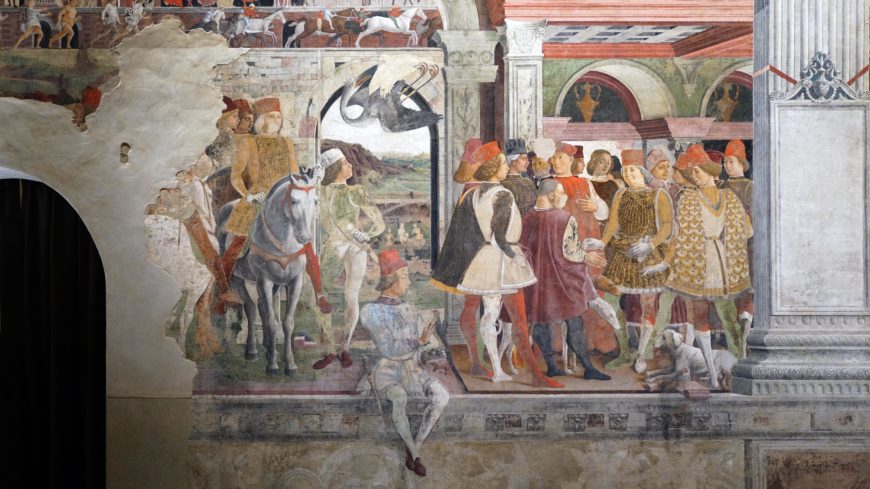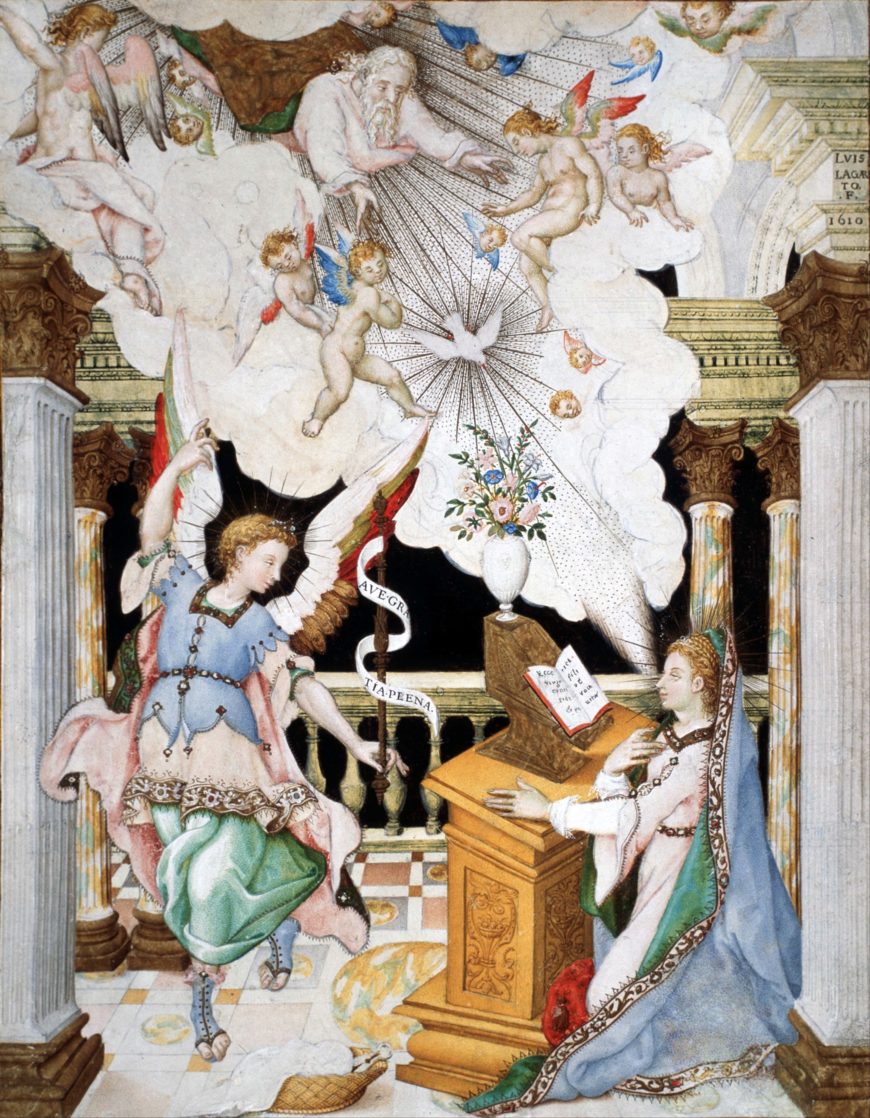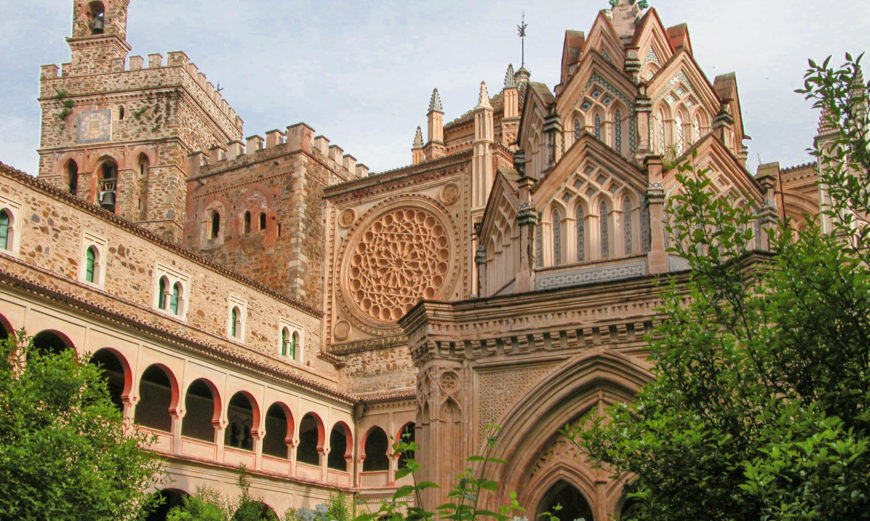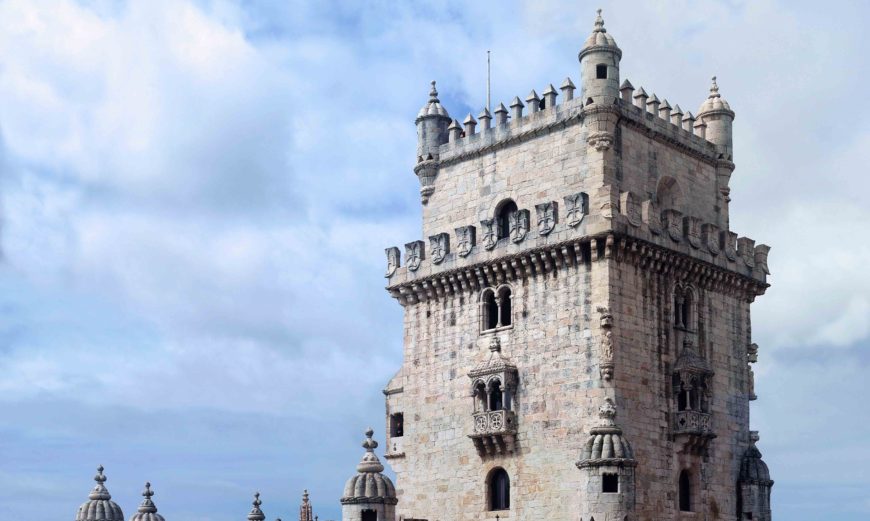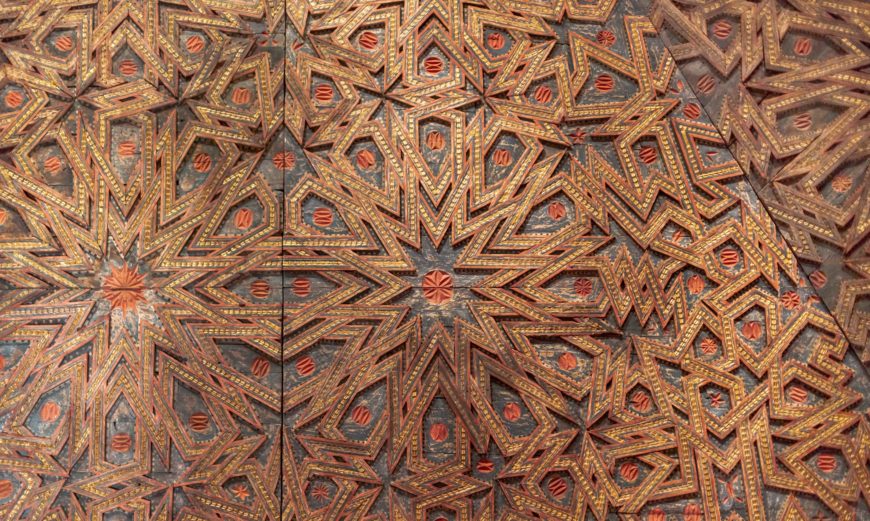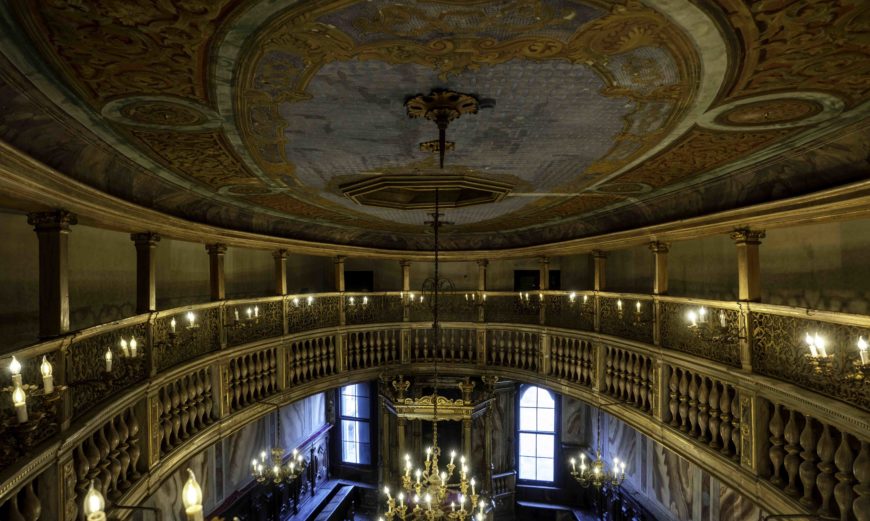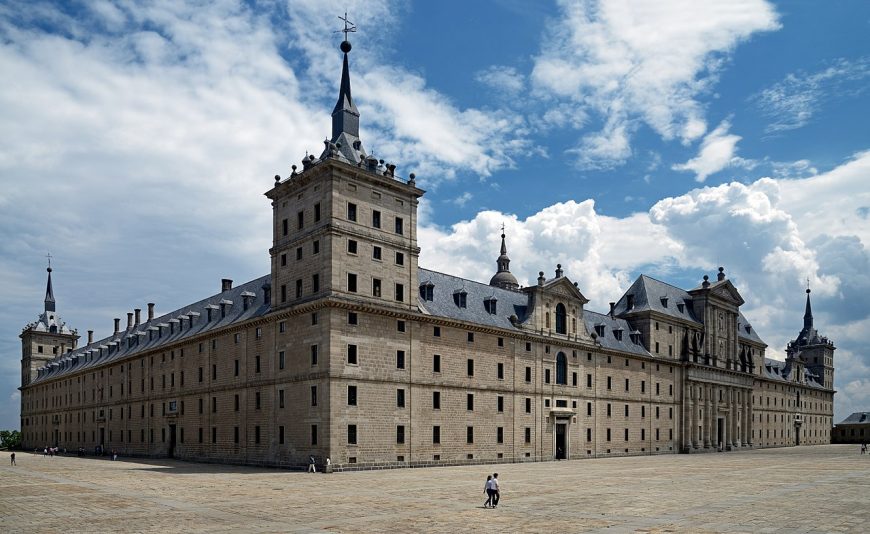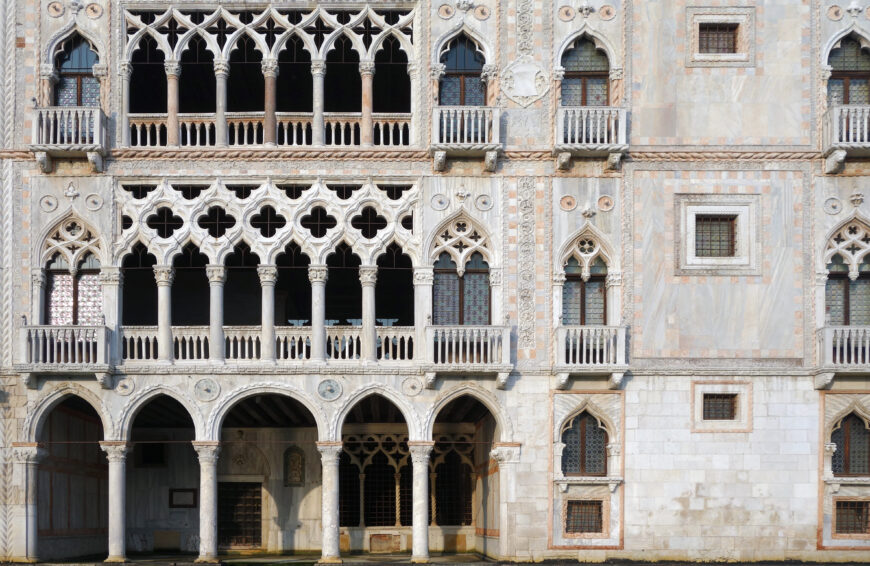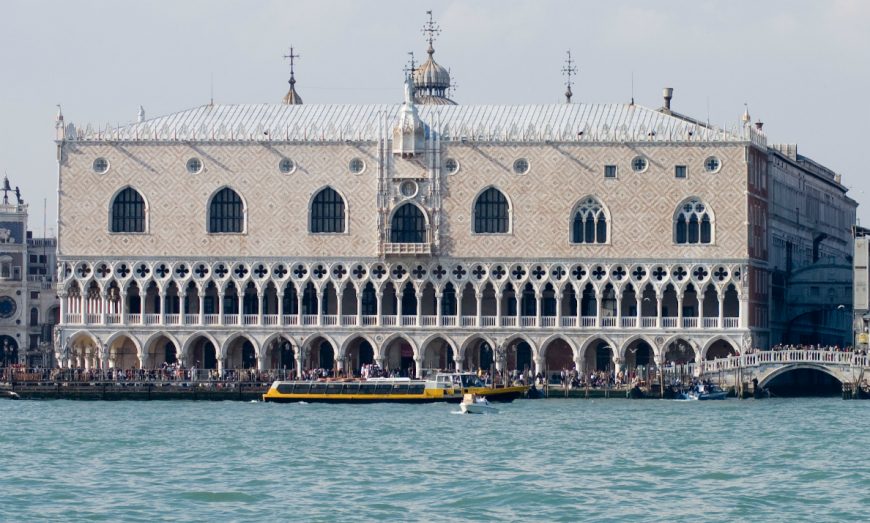This domestic building references ancient Roman architecture—and the nearby Medici palace.
Leon Battista Alberti, Palazzo Rucellai, c. 1446–51, Florence, Italy. Speakers: Dr. Beth Harris and Dr. Steven Zucker
[0:00] [music]
Dr. Steven Zucker: [0:05] Just a few years after the Medici Palace was completed, and only a few blocks away, one of the other wealthiest families in Florence built a palace.
Dr. Beth Harris: [0:14] There’s a whole boom in palace-building after the Medici built their palace, and so we’re looking at the Palazzo Rucellai, whose architect was the famous Alberti. Now, Alberti was a brilliant humanist. He wrote an important book on architecture in addition to his famous book on painting.
Dr. Zucker: [0:30] Alberti’s “On Architecture” is probably the most important treatise on architecture after the “Ten Books of Architecture,” by the ancient Roman, Vitruvius.
Dr. Harris: [0:37] Which had only been discovered a few decades earlier. There’s this whole revival of ancient Roman architecture. We see that a little bit in the Medici Palace, but we see it really here in the Rucellai Palace by Alberti.
Dr. Zucker: [0:50] What’s fascinating is that Alberti is looking back to Vitruvius’ ancient work, seeing this standardized vocabulary, and employing it in a self-conscious way that is announcing its historicism.
Dr. Harris: [1:02] Announcing it’s looking back to ancient Roman architecture. Alberti had been in Rome. He had studied ancient Roman architecture.
Dr. Zucker: [1:10] The classicism is not coming through only in the individual elements, but also in the emphasis on measure and harmony. Giovanni Rucellai came from a wealthy Florentine family of wool manufacturers.
Dr. Harris: [1:22] Like most wealthy Florentines, that’s how they made their money.
Dr. Zucker: [1:24] At this particular moment in Florentine history, it was important that Rucellai express his loyalty to the Medici family. Alberti was clearly referencing the Medici palace, and you can see that in the organization of the façade into three primary stories.
[1:39] There are also really important differences, and you can see that especially in the masonry. For example, this building is much more delicate. Gone is that heavy, dark, rusticated masonry that we saw in the earlier building.
Dr. Harris: [1:50] That gave the impression of the Medici Palace as being almost like a fortress, and recalling the Palazzo Vecchio.
Dr. Zucker: [1:56] This building feels much more intellectual in its geometry, its lightness, its sense of the cerebral.
Dr. Harris: [2:02] We see more classical elements here than we saw in the Medici palace. We have pilasters, rounded arches, although we did see that also in the Medici palace, but in between the stories, instead of just the string course we have a classical entablature, which gives us a sense of horizontality and which is filled with decorative patterns between the ground floor and the first floor.
[2:25] We see the Medici device of a diamond ring with three feathers coming out of it, and between the second floor and the third floor we see a device of the Rucellai family, of a sail that appears to be blowing in the wind.
Dr. Zucker: [2:37] If you start at the bottom, just like the Medici Palace, there are benches on the ground floor, which is an invitation for the citizens of the city to come and rest.
Dr. Harris: [2:45] The ground floor very much feels like the ground floor. It has a sense of weightiness that comes from that diamond pattern.
Dr. Zucker: [2:52] As you move up the façade, there are three sets of pilasters, each with different capitals. At the bottom, you see variations of the Tuscan tradition — the simplest, heaviest. Above that, a form of the Ionic, and then at the top, Corinthian.
Dr. Harris: [3:06] We see that differentiation of orders also if we go to the Coliseum in Rome, where at the bottom we have the Tuscan, the middle story is decorated with the Ionic order, and at the top with the Corinthian, so Alberti is clearly looking at ancient Roman architecture.
Dr. Zucker: [3:20] The building’s emphasis is not vertical, even though you’ve got the pilasters moving from top to bottom. Those pilasters are interrupted by these very elaborate entablatures that really emphasize the horizontality, the grounded quality of the building.
Dr. Harris: [3:34] Now, the building was never finished. About two-thirds of what Alberti intended is there. You can see it’s unfinished on the right side, and so there would have been a third entrance.
Dr. Zucker: [3:42] Alberti did more than simply the façade. The structure was remodeled on the inside, joining a number of preexisting independent structures.
Dr. Harris: [3:50] Now, Alberti may also have designed the loggia that is catty-corner to the Palazzo, to the palace. This is an open space with round arches, beautiful columns with Corinthian capitals, and pilasters on the interior wall, also very classicizing.
[4:06] This loggia may in fact have been built to commemorate a wedding between a member of the Medici family and the Rucellai family, so a joining of these two powerful Florentine families.
Dr. Zucker: [4:16] Actually, it’s important to note that it’s no longer an open loggia. It’s now got a glass covering and it’s a shoe store, but originally it would have been an open space that would have protected people as they walked through, and reminds us that even the palace is seen as a civic good, that this was adding to the beauty and the harmony of the city.
Dr. Harris: [4:34] We can see the building of the Palazzo, of the loggia, of this piazza in front, as part of the beautification of the city that happened in the 15th century. That civic pride that led the people of Florence to be interested in beautifying their city with great works of sculpture and architecture.
Dr. Zucker: [4:50] Here in the middle of the 15th century in the center of Florence, we have this invention of what humanism looks like applied to domestic architecture.
[4:58] [music]
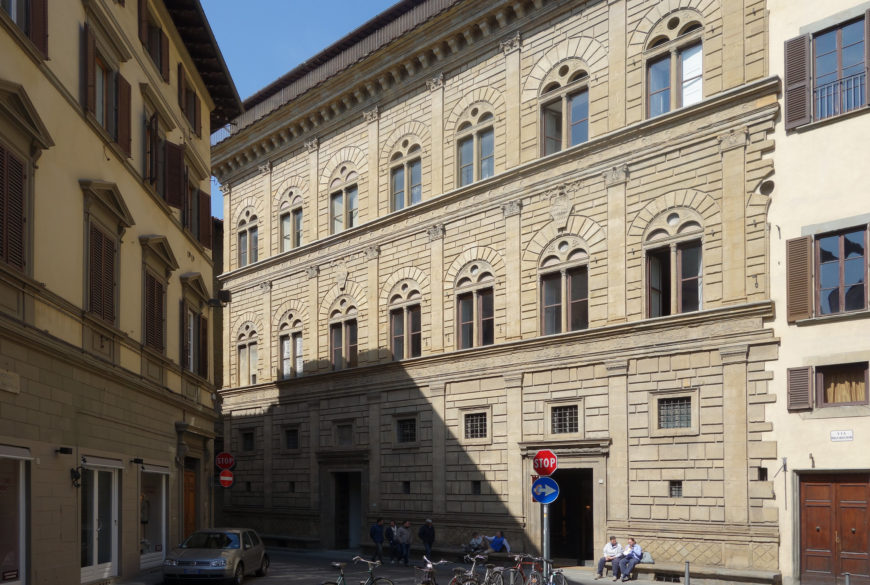
Leon Battista Alberti, Palazzo Rucellai, c. 1446–51, Florence, Italy (photo: Steven Zucker, CC BY-NC-SA 2.0)
Humanist architecture for a private home
By 1450, the skyline of Florence was dominated by Brunelleschi’s dome. Although Brunelleschi had created a new model for church architecture based on the Renaissance’s pervasive philosophy, Humanism, no equivalent existed for private dwellings.
In 1446, Leon Battista Alberti, whose texts On Painting and On Architecture established the guidelines for the creation of paintings and buildings that would be followed for centuries, designed a façade that was truly divorced from the earlier medieval style, and could finally be considered quintessentially Renaissance: the Palazzo Rucellai. Alberti constructed the façade of the Palazzo over a period of five years, from 1446–51; the home was just one of many important commissions that Alberti completed for the Rucellais—a wealthy merchant family.
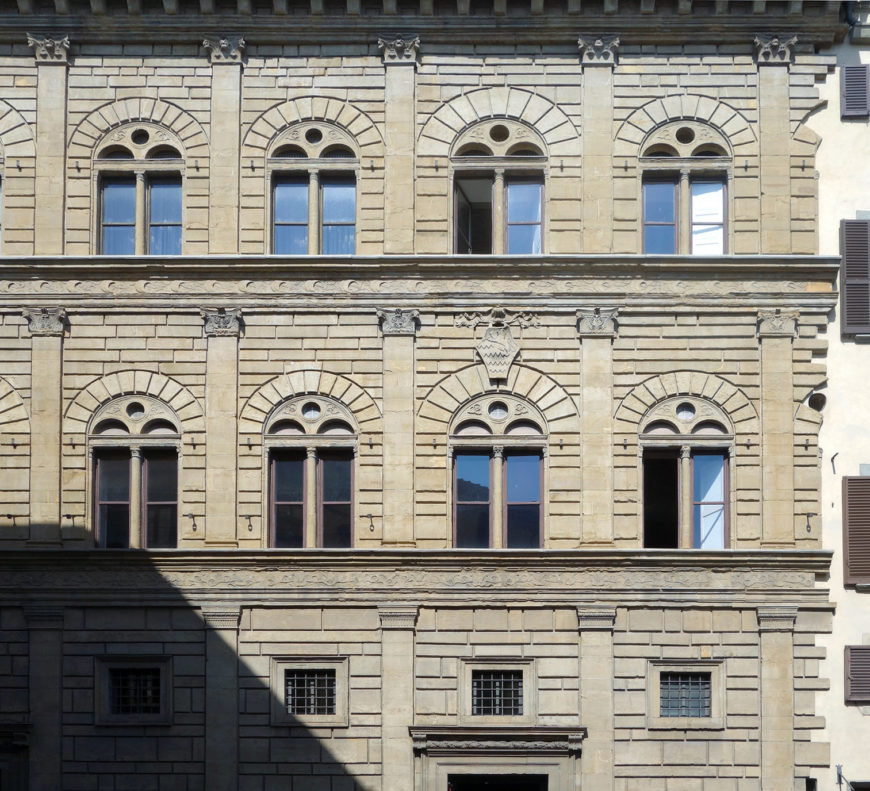
Leon Battista Alberti, Palazzo Rucellai, c. 1446–51, Florence, Italy (photo: Steven Zucker, CC BY-NC-SA 2.0)
Three tiers
Like traditional Florentine palazzi, the façade is divided into three tiers. But Alberti divided these with the horizontal entablatures that run across the façade. The first tier grounds the building, giving it a sense of strength. This is achieved by the use of cross-hatched, or rusticated stone that runs across the very bottom of the building, as well as large stone blocks, square windows, and portals of post-and-lintel construction in place of arches.
The overall horizontality of this façade is called “trabeated” architecture, which Alberti thought was most fitting for the homes of nobility. Each tier also decreases in height from the bottom to top. On each tier, Alberti used pilasters, or flattened engaged columns, to visually support the entablature. On the first tier, they are of the Tuscan order. On the second and third tiers, Alberti used smaller stones to give the feeling of lightness, which is enhanced by the rounded arches of the windows, a typically Roman feature. Both of these tiers also have pilasters, although on the second tier they are of the Ionic order, and on the third they are Corinthian. The building is also wrapped by benches that served, as they do now, to provide rest for weary visitors to Florence.
The Palazzo Rucellai actually had four floors: the first was where the family conducted their business; the second floor, or piano nobile (reception room), was where they received guests; the third floor contained the family’s private apartments; and a hidden fourth floor, which had few windows and is invisible from the street, was where the servants lived.

Alberti (?), Loggia Rucellai (now glassed in), Florence, Italy (photo: Steven Zucker, CC BY-NC-SA 2.0)
The loggia
In addition to the façade, Alberti may have also designed an adjacent loggia (a covered colonnaded space) where festivities were held. The loggia may have been specifically built for an extravagant 1461 wedding that joined the Rucellai and Medici families. It repeats the motif of the pilasters and arches found on the top two tiers of the palazzo. The loggia joins the building at an irregularly placed, not central, courtyard, which was probably based on Brunelleschi‘s Ospedale degli Innocenti.
The influence of ancient Rome
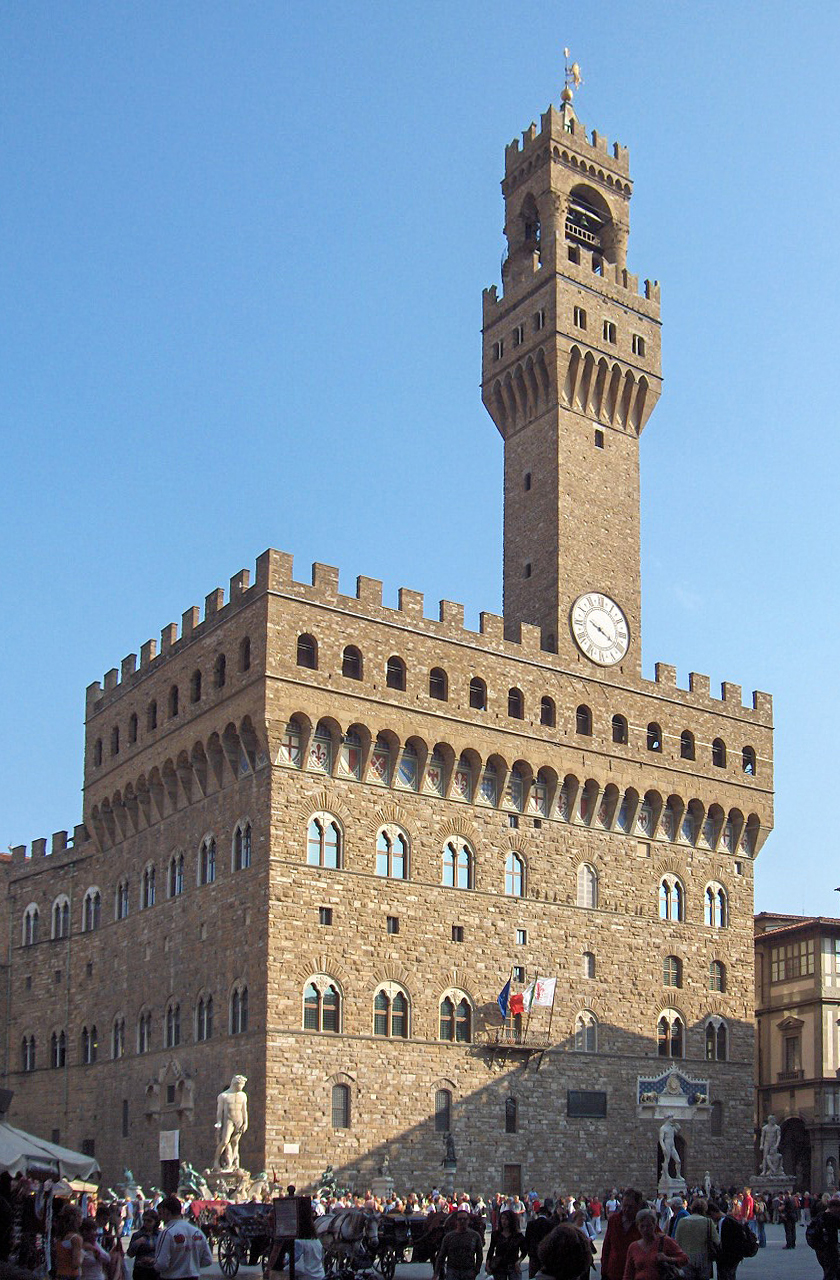
Arnolfo di Cambio (initial design), Palazzo Vecchio, 13th and 14th centuries, Florence, Italy (photo: JoJan, CC BY-SA 3.0)
In many ways, this building is very similar to the Colosseum, which Alberti saw in Rome during his travels in the 1430s. The great Roman amphitheater is also divided into tiers. More importantly, it uses architectural features for decorative purposes rather than structural support; like the engaged columns on the Colosseum, the pilasters on the façade of the Rucellai do nothing to actually hold the building up. Also, on both of these buildings, the order of the columns changes, going from least to most decorative as they ascend from the lowest to highest tier.
The Palazzo Rucellai has many features in common with the Palazzo Medici (below), which was constructed a few years before, not far from Alberti’s building. The Palazzo Medici is also divided into three horizontal planes that decrease in heaviness from bottom to top.
But there are subtle differences that betray the intents of the patrons. The bottom tier of the Palazzo Medici, built for Cosimo il Vecchio de’ Medici by Michelozzo, resembles the stone of the Palazzo Vecchio, the seat of political power of Florence, with which Cosimo intentionally wanted to associate himself. It also employs the same type of windows.
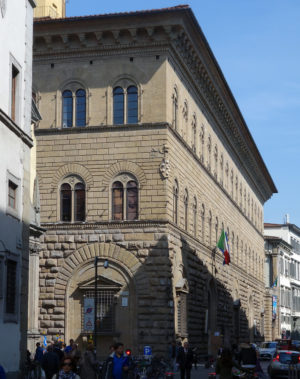
Michelozzo, Palazzo Medici, 1445–60, Florence, Italy (photo: Steven Zucker, CC BY-NC-SA 2.0)
Because Michelozzo used this medieval building as a model, whereas Alberti looked to ancient Rome, the Palazzo Medici is not truly Humanist in its conception and lacks the geometric proportion, grace, and order of the Palazzo Rucellai. The top tier of the Palazzo Medici is almost entirely plain, whereas Alberti continued to use architectural features for ornamentation throughout his design.
The main difference between the Palazzo Rucellai and other palazzi was Alberti’s reliance on ancient Rome. This may have reflected Giovanni Rucellai’s pretensions for his family. Rome was the seat of the papacy, and though Rucellai was not a cleric, he claimed to have descended from a Templar. The Palazzo Rucellai went on to influence the design for the homes of many clerics, such as the famous Palazzo Piccolomini that was built for Pope Pius II in Pienza by Bernardo Rossellino.


